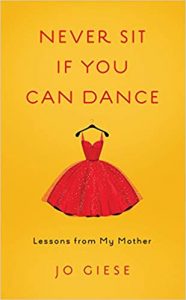Tips For Writing Non-Fiction
 I’ve just written my fourth non-fiction book, a mother-daughter memoir Never Sit If You Can Dance: Lessons from My Mother, which will launch for Mother’s Day 2019.
I’ve just written my fourth non-fiction book, a mother-daughter memoir Never Sit If You Can Dance: Lessons from My Mother, which will launch for Mother’s Day 2019.
I thought it might be fun to share some of the tricks and truths I’ve learned from writing non-fiction.
First, I never ever go anywhere without having a few notecards with me. Standard 3×5 white notecards. That’s so when I see or hear something that catches my attention I have a designated place to scribble it down. By now I know that I will not remember a fleeting comment, and even the most wonderful, juicy piece of dialogue can vanish from my mind unless I make a note of it. I also have a stash of these notecards in my car. (Yes, I can write short notes and drive at the same time.)
When I was writing my current book, which are lessons from my mother, I did this note-taking with my mom, too. I wanted to be sure and capture her language and her word choices.
When I’m finally in my office and about to start writing, first I always pause and light a candle on the far right-hand corner of my desk. Lighting the candle is my pre-writing ritual. The candle glowing on my desk signals for to me to stop and pay attention. It signifies that something important is about to happen—I’m about to start writing.
I was attending an author event at a bookstore when Isabelle Allende, the Chilean novelist, revealed that she also observes a lighting-the-candle ritual before writing.
So, the notes are taken, the candle is lit, and I’m ready to start. Once while I was working with Ira Glass, host of This American Life, he gave me an important bit of writer’s advice. We were working on a documentary, and I’d changed one little word in the script because I didn’t want to repeat the word green in the same sentence: the caregiver was wearing green spandex shorts, and she was in the US on a green card. So I changed the color of the shorts. Ira called me out on it. “Jo, the truth always things clear. Stick with the truth.”
This advice has stuck with me when I’m trying to fudge something to make it fit, and I stop myself, and say, “But what’s the Truth here? Will it ring True?”
The next lesson I’ve learned is that there’s always a time in the process when the writing that it feels like a slog. The excitement of catching the idea is over. The first draft is down. But the writing hasn’t taken shape. Yet. It’s time to revise and revise and revise. This always feels messy—like a miserable slog. It’s also the time when less experienced writers might get discouraged and lose confidence: this isn’t amounting to anything; it isn’t as good as I thought it would be; I give up.
My advice: hunker down and barrel through the revisions, and the writing will take form and start to sparkle.
Remember the person who revises and edits is a different person than the writer who wrote the piece. I acknowledge this by moving to a different location to edit. I take the printed hard copy downstairs and edit it at the dining room table. Different person, different skill set, different location. I read about someone who puts on a red sweater when they edit. Sounds about right.
Also, while you’re editing you’ll find that a favorite passage doesn’t fit in the piece you’re working on. This is where a SAVES file comes in. It’s painful to delete a favorite passage, so toss it in the SAVES file. You may never use or need that passage again, but if it’s in the SAVES file it still exists, and you won’t feel so bad about losing it in this draft.
Now is the time to read your piece out loud. Read it to yourself. Read it to your friends. (Select these friends carefully. Kind, thoughtful listeners. You don’t need a super critique now. You need encouragement to go on.) See how the words sound. See what reaction you get from friends. There may be sections that are totally understandable to you but leave your audience bewildered, as in “What’s that about?” Abe Lincoln always read his writing out loud. What worked for Abe, can work for us.
Now you’re ready to send your wonderful-funny-sad piece out into the world. Be sure to research the publication where you’re sending it. If the publication never uses first person essays, do not send them your first person essay. They’re not going to change their publication style no matter how wonderful your piece may be.
Here’s where rejections come in. My most memorable rejection was on an 8 x 11 piece of white paper where the editor had written NO in the center. That was it. No. A writer’s ability to live and work in the world will be determined by how well the writer handles rejections and how well the writer forges ahead in spite of them. One way to think about rejections is that you didn’t send your lovely piece to the right editor.
Publishing day. This is fun! Whether your piece appears online to a niche audience or you’ve made a splash in the New York Times, getting published is something to celebrate. Congratulations!
—
Jo Giese is a award-winning radio journalist, author, teacher, community activist. Her book Never Sit If You Can Dance: Lessons from My Mother will be published for Mother’s Day 2019.
https://www.facebook.com/authorjogiese/
https://www.twitter.com/jogiese7
https://www.instagram.com/giesejo
https://twitter.com/shewritespress
https://www.facebook.com/shewritespress/
Never Sit If You Can Dance: Lessons from My Mother
 Jo’s mother, Babe, liked to drink, dance, and stay up very late. When the husband she adored went on sales calls, she waited for him in the parking lot, embroidering pillowcases. Jo grew up thinking that the last thing she wanted was to be like her mother. Then it dawned on her that her own happiness was derived in large part from lessons Babe had taught her. Her mother might have had tomato aspic and stewed rhubarb in her fridge, while Jo had organic kale and almond milk in hers, but in more important ways they were much closer in spirit than Jo had once thought.
Jo’s mother, Babe, liked to drink, dance, and stay up very late. When the husband she adored went on sales calls, she waited for him in the parking lot, embroidering pillowcases. Jo grew up thinking that the last thing she wanted was to be like her mother. Then it dawned on her that her own happiness was derived in large part from lessons Babe had taught her. Her mother might have had tomato aspic and stewed rhubarb in her fridge, while Jo had organic kale and almond milk in hers, but in more important ways they were much closer in spirit than Jo had once thought.
At a turbulent time in America, Never Sit If You Can Dance offers uplifting lessons in old-fashioned civility that will ring true with mothers, daughters, and their families. Told with lighthearted good humor, it’s a charming tale of the way things used to be―and probably still should be.
Category: Contemporary Women Writers, How To and Tips

























